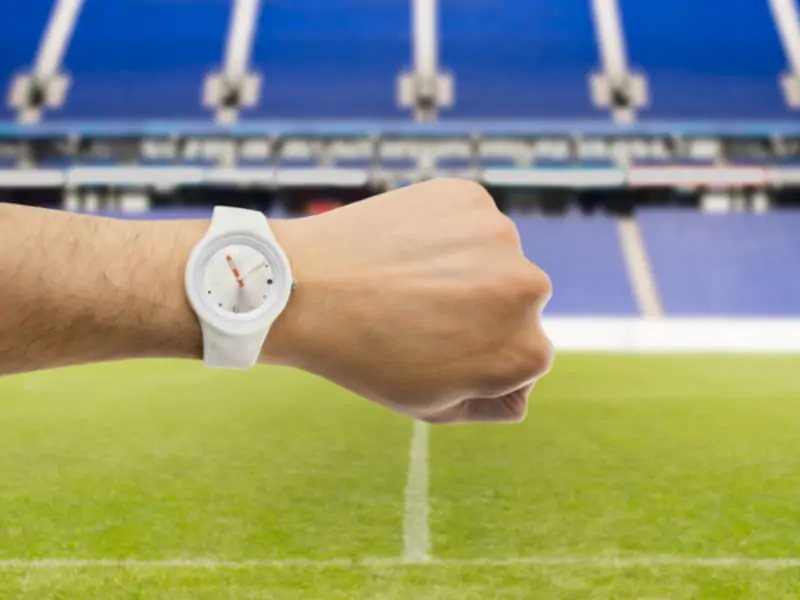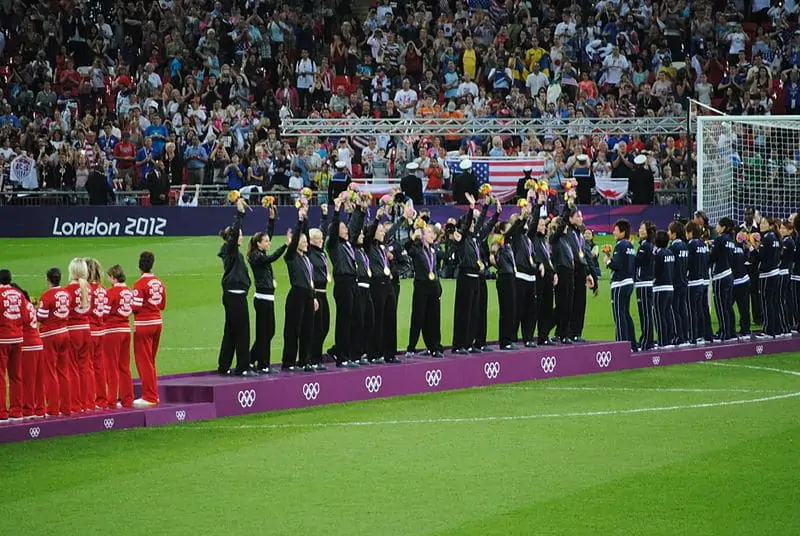Share the post "How Long is a Soccer Game (Leagues, Cup, Youth, School)"
Throughout college soccer, my coaches always talked about how important it was to stay focused for the length of a soccer game, 90 minutes.
However, we needed to stay focused for quite a bit longer. Sometimes our games lasted 110 minutes with overtime. But a professional game can be 120 minutes or even much longer.
A soccer game is two 45-minute halves, but that doesn’t indicate how long the game will take. In reality, some games (like youth games) are much shorter, while other games can be significantly longer.
Today we’ll look at how long soccer games take and what factors influence the time of a soccer game.
We’ll dive into:
- How long is a soccer game
- Soccer game length rules
- Over time and added time
- Soccer game lengths for different ages
Understanding how long a soccer game can go will help you prepare as a player and viewer!
Update: The 2022 World Cup now has more added time on at the end of the first half and the second half for injuries, corners, throw ins, and goal celebrations. Instead of 1-2 added at the end on the first half, you will see 5+, and after 90 minutes you might see 8+ minutes added, depending on if there have been many breaks in play. This is so that you see more action - who knows if it will continue after the World Cup to the national leagues.

- How long is a soccer game in real-time?
- How many innings are in a soccer game?
- How long is a soccer game on tv
- What are the final minutes of a soccer game called?
- Why does a soccer game go over 90 minutes?
- How long is a soccer game with added Time?
- How long is a soccer game with extra Time?
- What does FT mean in soccer?
- What is the longest soccer game ever?
- Soccer Game Length by Age
- How long is a middle school soccer game?
- How long is a soccer game in high school
- How long are soccer games in college?
- How long is a soccer game in the Olympics?
- How long is a soccer game world cup?
- How long is extra time in FIFA?
- Soccer Time
How long is a soccer game in real-time?
Soccer games include two 45-minute halves, which is 90 minutes of play. Like many sports, those who have ever watched a game know that real-time is longer than the match time.
In real-time, the length of a soccer game varies immensely. At the bare minimum, it will be 90 minutes of play + 15 minutes of halftime for 105 minutes.
However, soccer games rarely hit 105 minutes exactly in real-time.
How many innings are in a soccer game?
Soccer games do not have “innings.” While baseball games have nine innings, soccer games do not use this term. Simply put, soccer has 0 innings.
Instead, professional soccer uses halves. Youth soccer may have quarters, with breaks in between. Officially, soccer has two 45-minute halves.
How long is a soccer game on tv
Live soccer games are a minimum of 105 minutes; two 45-minute halves and a 15-minute halftime. However, they will generally be a bit longer due to added time.
There’s no way to know how long a soccer game on TV will take, as it depends on the unique events and set up for the game.
For example, a regular professional league game can end in a tie, but an elimination game cannot. An elimination game that ends in a tie must go to overtime, where it may have a winner after halftime. On the other hand, it will go to penalty kicks if nobody wins in overtime.
Based on the example above, a regular professional game with no added time could end in 105 minutes. A professional elimination game that goes all the way to penalty kicks could take 145 minutes or more.

What are the final minutes of a soccer game called?
Rarely does a soccer game ends at the exact 45 minutes of the half ending. Instead, the final minutes of a soccer game is what the referee adds due to stoppage. These minutes are referred to as:
- Added time
- Stoppage time
- Injury Time
Why does a soccer game go over 90 minutes?
It’s fairly common for a soccer game to exceed 90 minutes. At the same time, the clock does not stop in soccer (for injuries, subs, etc.); referees track added time.
When there is a delay in play, the referee can add this lost time to the end of regulation play. The referee announces the added time after that period.
For example, if it took 5 minutes to remove an injured player and re-start play, the referee may add five minutes to that half in extra time.
Some of the most common reasons for added time include:
- Injuries
- Substitutions
- Time wasting from players
- Arguments/altercations
In addition to added time, soccer games exceed 90 minutes because of overtime (extra time). Overtime happens when the teams are tied at the end of regulation play.
Overtime is not used this way at all levels of soccer. For example, professional teams will not go into overtime unless the game is an elimination round.
The length and rules of overtime vary based on the level of soccer, but it typically includes two 10-15 minute halves. If it is an elimination game and the teams remain tied after overtime, they will go to penalty kicks.
If a college game goes through extra time (with 10-minute halves and 2-minute halftime) and penalty kicks, it can easily add over 30 minutes to the game.

How long is a soccer game with added Time?
With added time (time added for stoppages), a soccer game can exceed the typical 90 minutes of play. The amount of extra play determines the exact length added at the referee’s discretion.
FiveThirtyEight evaluated the average stoppage time added to games for the Men’s World Cup 2018. They found that the average extra time added was 6 minutes and 59 seconds total, but it should have been about 13 minutes and 10 seconds based on FIFA’s guidelines.
Our findings confirmed what avid fans already know: Actual stoppage time is a wildly inaccurate measure of how long the game was actually stopped.
FiveThirtyEight
Ultimately, how long a soccer game is with added time depends greatly on the events of the game and the assessment of the referee.
How long is a soccer game with extra Time?
Extra time, or overtime, is added to an elimination game that ends in a tie. Note that all college soccer games ending in a tie head to overtime, though the game can finish in a tie after overtime (if it’s not an elimination game).
Here’s a breakdown of extra time:
- U10 and younger: no extra time
- U11-U13: Two 10-minute halves of extra time may vary
- U15-U18:Two 15-minute halves may vary
- High School Soccer: Two 10-minute overtime halves
- College Soccer: Two 10-minute sudden-victory halves
- Professional Soccer: Two 15-minute overtime halves
What does FT mean in soccer?
FT is a soccer abbreviation that stands for “full time.” Full time is the end of the game, after the regulation 90 minutes and any added time.
When showing results, most sites will mark with “FT” to differentiate from half time (HT). This way, viewers know if the score they see is mid-game or the final score for the game.
What is the longest soccer game ever?
The rules on the length of a soccer game and extra time changed over time. In the past, the game laws allowed for successive extra time!
The longest soccer game may have been in 1922 when 1.FC Nürnberg played against Hamburger SV in the German Championship. The game was called 2-2 in the 189th minute because dusk was setting in.
According to the Guinness World Records, the longest soccer game was 108 hours! This “game” was a charity marathon to raise money for the British Heart Foundation. Heartbeat United hosted it in the UK in 2016.

Soccer Game Length by Age
Official soccer games are two 45-minute halves. However, soccer games for kids vary by age. Here’s a breakdown of soccer game length by age in the U.S.
| Age | Half or Quarter? | Duration of Each Section | Total Game Length |
| U6 | Quarters | 6 minutes | 24 minutes |
| U7 & U8 | Quarters | 12 minutes | 48 minutes |
| U9 & U10 | Halves | 25 minutes | 50 minutes |
| U11 & U12 | Halves | 30 minutes | 60 minutes |
| U13 & 14 | Halves | 35 minutes | 70 minutes |
| U15 & U16 | Halves | 40 minutes | 80 minutes |
| U17 and up | Halves | 45 minutes | 90 minutes |
How long is a 6-year-old soccer game?
A game for U6 (under 6) is a total of 24 minutes. The game is broken down into 4 quarters of 6 minutes long. There is a short break between each quarter.
How long is a 7-year-old soccer game?
Games for 7-year-olds are a total of 48 minutes. The game is broken down into 4 quarters of 12 minutes long. There is a short break between each quarter.
This format is used for U7 and U8 teams.
How long is a 9-year-old soccer game?
Once kids enter U9 soccer, the length of the game increases again. So, how long do U9 football games last?
U9 and U10 soccer games change from quarters to half. At this age, kids play two halves of 25 minutes.
How long are U12 football games?
For U11 and U12, games increase in length again. U12 soccer games are two halves of 30 minutes, so one hour of play total.
How long is a soccer game for 13-year-olds?
U13 and U14 soccer games are longer than U11/12 games. For this age group, games are two halves of 35 minutes.
How Long is a U16 Soccer Game?
For the U15 and U16 age bracket, games still get longer. These ages play two halves of 40 minutes.
How Long is a U18 Soccer Game?
From U17 and above, soccer games are regulation length. This means U17, U18, and U19+ soccer games are two halves of 45 minutes.
How long is a middle school soccer game?
Based on the IFAB Laws of the Game, most middle school soccer games include two 30 or 35-minute halves. Therefore, they tend to include between 60 and 70 minutes of play.
Middle school tournament rules can vary depending on players’ age and the event type.

How long is a soccer game in high school
Each state determines the length of high school soccer games. Still, the state-governed rules must adhere to those of the National Federation of High School Associations.
High school games generally include two 40-minute halves for 80 minutes of play. They also include a 10-minute halftime, but the coaches and referee can agree to shorten the halftime.
In the event of a tie game, the teams play two 10-minute overtime halves. The specific overtime rules vary by state.
How long are soccer games in college?
College soccer games are 90 minutes or two 45-minute halves. Half time is 15 minutes. Including half-time, the college soccer games take about one hour and 45 minutes.
However, it will be overtime if the game is tied after the regulation time. College soccer overtime includes up to two 10-minute periods. Overtime is the “golden goal” which means that if one team scores in overtime, they immediately win and end the overtime.
Two sudden-victory overtime periods of 10 minutes each shall be played. If the score still is tied at the end of the second sudden-victory overtime period, the
NCAA Soccer
game shall be recorded as a tie.

How long is a soccer game in the Olympics?
Olympic soccer games are 90 minutes, with two 45-minute halves. In elimination rounds, tied games will go into two overtime periods of 15-minutes.
If a winner is not determined at the end of overtime, then the teams proceed to a penalty-kick shootout to determine a winner.
How long is a soccer game world cup?
For both the Men’s and Women’s World Cup, games include two 45-minute halves. Referees commonly add stoppage time to the end of each half.
Like the Olympics, the elimination rounds include two 15-minute overtime halves when teams are tied at the end of regulation play.
If no winner is determined in overtime, the teams proceed to a penalty kick shootout.
How long is extra time in FIFA?
In FIFA-sanctioned games, extra time following a tie in an elimination game is 15 minutes. Teams play for two 15-minute halves, regardless of scoring during those halves.
At the end of the overtime, a winner may be determined. If the score is tied following the overtime periods, the teams head to a penalty kick shootout.
How extra time works is just one way that FIFA video game simulates the real game, which is why so many soccer lovers enjoy playing it. Get FIFA 22 to see for yourself!
Soccer Time
The bottom line is that official adult soccer games include two 45-minute halves, 15-minute halftime, and added time due to stoppages.
Youth soccer has shorter halves (and even quarters) at some levels. College soccer games are the same length as professional games until added time and extra time.
Ultimately, the real-time and TV length of a soccer game depends on the details of the specific match. If extra time and penalty kicks are involved, a soccer game may be as short as 105 minutes or exceed 145 minutes.
The most important thing is to prepare as a player, coach, or fan to be in it for the whole game!
Share the post "How Long is a Soccer Game (Leagues, Cup, Youth, School)"
Joel is a seasoned soccer journalist and analyst with many years of experience in the field. Joel specializes in game analysis, player profiles, transfer news, and has a keen eye for the tactical nuances of the game. He played at various levels in the game and coached teams - he is happy to share his insight with you.



